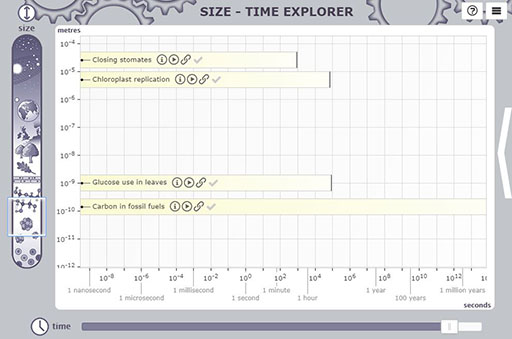2 Exploring scales in space and time
An interactive ‘space-time explorer’ has been built for you to investigate, to help you develop an appreciation for different scales in space and time that are encountered in science. It houses much of the learning content for this course.
The size–time explorer provides videos and slide shows that describe processes at very different scales. In addition to observing these processes, the visual resources are accompanied by a series of self-assessment questions in which you will make calculations relating to the processes selected to appreciate the significance of the scales. As an example, in one question you will use data from a video to work out how many leaves an 800 year old oak might produce in its lifetime (hint: it’s a lot!).
The explorer is an interactive graph, with time in seconds on the x-axis, and size in metres on the y-axis. The numbers on each axis are presented as powers of ten on a logarithmic scale (usually referred to as a log scale), which allows a large range in scales to fit in a small space.
On the graph, there are the 13 levels, shown as cream-coloured bars, which each represent a process. You will be making measurements and carrying out calculations using data from the resources provided in these levels, so it might be helpful to have a pen and paper ready for making notes, as well as a calculator. Some levels also include links to an activity within the explorer where you will add entries to the existing scales.
Here is the size–time explorer. Open the explorer in a new browser tab or window and leave it open there, to help you to navigate between it and the associated questions. There are instructions for what you will need to do in the next section, but for now, familiarise yourself with the interface:
- use the ‘?’ (‘Help’) button for instructions on how to navigate around the explorer
- scroll along both axes to see what scale levels are available
- play a video/or a slide show (the ‘Oak tree’ level is a good one to start with)
- The hyperlinks (chain-link symbols) in the size-time explorer are not active, but the questions may be accessed directly from subsections 2.1 to 2.13 of the material in this course.

Activity 1 Explore scales in space and time
To begin, access the size–time explorer and pick one of the 13 levels of scale. It is recommended that you start at the oak tree, as this should be a fairly familiar level of scale.
In the explorer, for each level you will find a brief description and also a resource in the form of a short video or slide show with accompanying audio. Familiarise yourself with the resource and then click on the ‘Link to materials’ icon for that level to access some associated questions.
You will then be asked to watch the video or slide show again, this time making notes about specific things. Armed with this information, you should then work through the questions presented.
You should aim to spend 30–40 minutes studying each level and answering the associated questions, although you may find that some sections can be completed in a shorter time period. Note that you can also use the checkboxes within the explorer to mark levels complete once you have finished studying them.
You can either study the levels of scale by investigating the size–time explorer or you can work through the levels given in the following sections on this course. The choice is yours; the content is the same, but it may help you to appreciate the relationship between levels if you return to the tool between activities.
Study note
The questions within the sections that follow are entirely formative, and answers/feedback will be given as you go along. This means that answers you put in will not be saved if you break from the quiz, so close down your browser and return to it later on.
